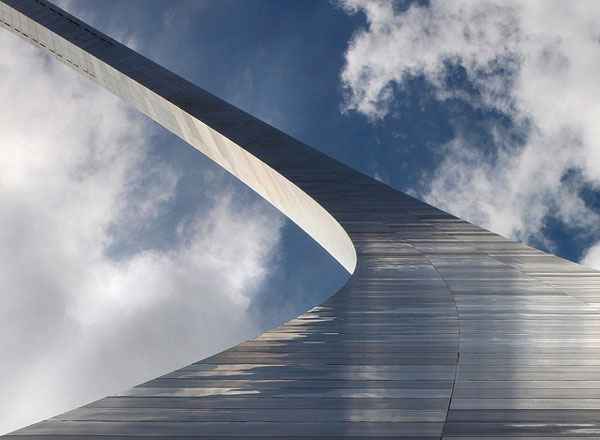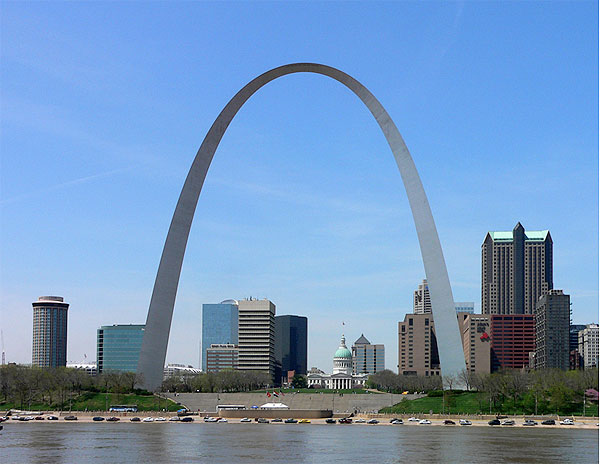Arch
by Roger Kaza
Today, a chain and an arch. The University of Houston presents this program about the machines that make our civilization run, and the people whose ingenuity created them.
Eero Saarinen had a problem. The Finnish architect was holding a drooping chain between his hands. He was illustrating a point to his structural engineer, Hannskarl Bandel. A hanging chain forms a catenary curve, a well-known geometric form. But geometry wasn't the issue. It didn't look right. Look right for what? Well, try flipping that chain upside down in your mind's eye and multiply by, say, 600. Saarinen and Bandel were staring at the future Gateway Arch, the tallest monument in the country, the largest arch ever built. They were drawing the blueprints. Saarinen wanted his arch to have a soaring feeling, and the hanging chain just wasn't quite it.
The story goes that Bandel then took the chain and said, give me a few days. When he came back, he'd replaced some of the links in the middle of the chain with smaller ones. That changed the weight of the curve'just a bit. Saarinen was elated. The Arch had found its shape.

But, why an arch at all? The 38-year-old architect had won a prestigious competition for a new national monument, sited for the banks of the Mississippi in downtown St. Louis. He had edged out 171 other competitors, including his own father. The vote was unanimous, and for good reason. Saarinen explained that an "absolutely simple shape" was the basis of memorials that have kept their significance over time, such as Egypt's pyramids. He decided against the classic rainbow-shaped Roman arch or the peaked Gothic arch. A catenary curve arch wasn't unknown in architecture, but it wasn't very common, either. And now Bandel's modified chain was an arch no one had ever seen before.

A catenary curve is the shape of a hanging chain supporting only its own weight.
Construction began in 1963. The sides of the arch are stainless steel equilateral triangles, 54 feet wide at the base. They shrink to a mere 17 feet at the top — Bandel's skinny chain links. The building tolerances were insanely tight. Off by more than a 64th of an inch at the bottom, and the two sides wouldn't meet up at the top. St. Louisians watched as the legs of their arch grew closer together. When the last center triangle was finally hoisted into place, massive hydraulic presses pushed the legs apart to accept the joining piece. Two precarious halves became an invincible whole. The Gateway Arch is so strong it sways only 16 inches in tornado-force winds.
Sadly, Saarinen never saw it. He died during surgery for a brain tumor, shortly before construction. The arch was completed in 1965. It's meant to commemorate the story of our nation's westward expansion, and the audacity of the men and women who achieved it. But, try standing right next to this giant gleaming icon, and look straight up. Gravity vanishes as the steel road vaults 630 feet into the sky, then returns to earth. It's a dizzying effect, and covered wagon trains are probably about the last thing you're thinking of. That's okay. Audacity, period, is the story of Eero Saarinen's magnificent arch.
I'm Roger Kaza, at the University of Houston, where we're interested in the way inventive minds work.

The Gateway Arch is often described as a catenary arch, and the description is partially true. Neither the exterior dimension (extrados) nor the interior (intrados) is a pure catenary curve. But an 'imaginary' center dimension, going precisely through the middle of the arch, is. Bandel's and Saarinen's innovation of a tapered, diminishing structure, aside from its aesthetic value, accomplished several things. It transferred the weight of the arch downward, whereas a pure catenary pushes the stress outward. It allowed the Arch to gain an additional 40 feet from its original proposed height of 590 feet. The arch's structural integrity comes from its stressed stainless steel skin, similar to airplane wings, which bear much of the load. This is attached to an inner wall of carbon steel. In addition, the base of the arch is reinforced with concrete. It extends all the way to the 300 feet level, three feet thick at the base and one foot thick higher up, and this, along with reinforcing steel rod, accounts for much of the Arch's strength.
It is said that in ancient Roman times, the builder/designer of an arch was required to stand under it as the wooden scaffolding was removed. Quality control!
Wikipedia entries for Saarinen and Bandel.
The geometry of a catenary curve was explored by Galileo. Robert Hooke examined it in the context of architecture.
As this piece was being written, the Gateway Arch is in the first stages of a major renovation of its surrounding environs, intended to be complete by 2015, the 50th anniversary of the completion of the Arch. The contract was won by the New York landscape design firm MVVA.
The official name for the Gateway Arch monument (rarely used by locals) is the Jefferson National Expansion Memorial. Underneath the Arch is a museum recounting the history of American westward expansion, starting with the Louisiana Purchase. A coincidental note: the word 'catenary' is usually credited to Thomas Jefferson.
Close-up photo of the Arch: 'Swoosh' by architect Chris Schroeer-Heiermann. Click here for impressive larger images and more info. Thanks to the architect for his photo.
Arch/St. Louis skyline photo and catenary graph, courtesy Wiki commons.